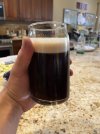- Joined
- Feb 2, 2015
- Messages
- 1,858
- Reaction score
- 3,050
- Points
- 113
Not all apple flavors are consider "bad". American lagers are famous for a red apple flavor which is caused by ethyl hexanoate. Acetaldehyde has a characteristic green apple flavor, more vegetal and not pleasant at all. The red apple character can add a pleasant background to the malt. Most people don't pick up on it until it's pointed out.Apple and plastic is from acetaldehyde. tied to yeast health and ending fermentation too soon. You always want to let the beer sit for a few days after active fermentation is done.
Less experienced judges will call all apple flavors in lager beers as caused by acetaldehyde, which frustrating when some beers (American Lager) actually are expected to have some level of red apple.
I'll get off my soap box now, it just pisses me off when judges expect American lagers to be as clean as German lagers. They're not.












